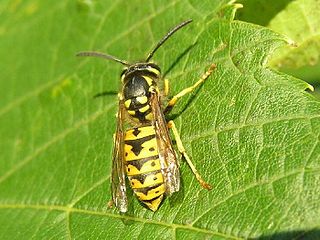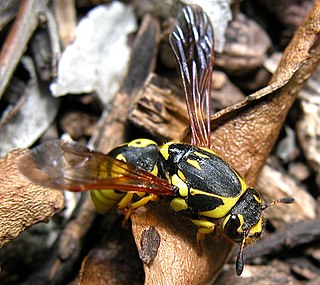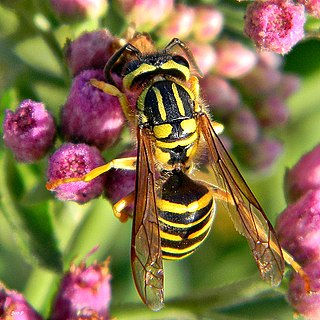
Vespula is a small genus of social wasps, widely distributed in the Northern Hemisphere. Along with members of their sister genus Dolichovespula, they are collectively known by the common name yellowjackets in North America. Vespula species have a shorter oculomalar space and a more pronounced tendency to nest underground than Dolichovespula.

Paravespula is a small subgenus of yellowjacket wasps, including some of the best-known wasp species in the world: the German wasp, Vespula germanica; the eastern yellowjacket Vespula maculifrons; the western yellowjacket Vespula pensylvanica; and the common wasp, Vespula vulgaris. It is occasionally treated as a separate genus, but this is not widely accepted.

The Encyclopedia of Life (EOL) is a free, online collaborative encyclopedia intended to document all of the 1.9 million living species known to science. It is compiled from existing databases and from contributions by experts and non-experts throughout the world. It aims to build one "infinitely expandable" page for each species, including video, sound, images, graphics, as well as text. In addition, the Encyclopedia incorporates content from the Biodiversity Heritage Library, which digitizes millions of pages of printed literature from the world's major natural history libraries. The project was initially backed by a US$50 million funding commitment, led by the MacArthur Foundation and the Sloan Foundation, who provided US$20 million and US$5 million, respectively. The additional US$25 million came from five cornerstone institutions—the Field Museum, Harvard University, the Marine Biological Laboratory, the Missouri Botanical Garden, and the Smithsonian Institution. The project was initially led by Jim Edwards and the development team by David Patterson. Today, participating institutions and individual donors continue to support EOL through financial contributions.

The yellow-eared woodpecker is a species of bird in the family Picidae. It is endemic to humid Atlantic Forest in eastern Brazil. Its common name refers to the yellow nape of both sexes - a feature not shared by any other Veniliornis in its range.

The eastern yellow jacket or eastern yellowjacket is a wasp found in eastern North America. Although most of their nests are subterranean, they are often considered a pest due to their nesting in recreational areas and buildings. This yellow jacket is a social insect, living in colonies of hundreds to thousands of individuals. Along with their subfamily, Vespinae, this species demonstrates supportive parental care for offspring, separation of reproductive and sterile castes, and overlapping generations. They aggressively defend their hives from threats and are known to inflict painful stings.

Pseudomasaris is a genus of pollen wasps of the family Vespidae, found in North America. They feed their larvae on the pollen and nectar of plants in the genus Phacelia. They are colored black with yellow or white markings that, in a few species, mimic the coloration of yellowjackets.

Anthidium maculifrons is a species of bee in the family Megachilidae, the leaf-cutter, carder, or mason bees.

Vespula squamosa, the southern yellowjacket, is a social wasp. This species can be identified by its distinctive black and yellow patterning and orange queen. These yellowjackets are typically found in eastern North America, and its territory extends as far south as Central America. Within these territories, they create enormous, multiple-comb nests. The colonies may be either annual or perennial depending on the climate, and in many perennial nests, polygyny takes place. In addition, this species uses pheromones both as a sexual attractant and an alarm signal. This species feeds on insects and animal carcasses; it does not produce honey. V. squamosa, a social insect, has developed a parasitic relationship with the species V. vidua and V. maculifrons. Due to their painful, venomous stings, the species is considered a pest.

Calodesma maculifrons is a moth of the family Erebidae. It was described by Francis Walker in 1865. It is found in Mexico, Honduras, Costa Rica, Guatemala, Panama and Ecuador.

Anacaenini is a tribe in the subfamily Hydrophilinae of aquatic beetles, and it contains 256 species in 6 genera.

Poecilopompilus is a fossorial genus of the family Pomplidae found in the New World. The main prey of these wasps are spiders of the family Araneidae.
Esthlogena maculifrons is a species of beetle in the family Cerambycidae. It was described by James Thomson in 1868. It is known from Brazil.
Phymasterna maculifrons is a species of beetle in the family Cerambycidae. It was described by Charles Joseph Gahan in 1890. It is known from Madagascar.
Peripsocus is a genus of stout barklice in the family Peripsocidae. There are more than 250 described species in Peripsocus.
Epilampra is a genus of cockroach in the family Blaberidae. There are more than 70 described species in Epilampra.
Crenitis morata is a species of water scavenger beetle in the family Hydrophilidae.
Crenitis is a genus of water scavenger beetles in the family Hydrophilidae. There are about 19 described species in Crenitis.

Atomaria is a genus of silken fungus beetles in the family Cryptophagidae. There are more than 160 described species in Atomaria.
Stylurus spiniceps, the arrow clubtail, is a species of clubtail in the dragonfly family Gomphidae. It is found in North America.
Hemiandrus maculifrons is a species of ground weta endemic to New Zealand. They are nocturnal, carnivorous, and flightless orthopterans belonging to the family Anostostomatidae. Being a nocturnal species, individuals remain in underground tunnels (galleries) during the day and emerge from their burrows after sunset to forage and hunt for small invertebrates. H. maculifrons is one of the smallest New Zealand weta species, averaging 15 mm in length and weighing 1-3 g. Unlike the tree weta and tusked weta, where sexual dimorphism is found in the form of male weaponry, ground weta only exhibit sexual size dimorphism: the females are larger than the males.













